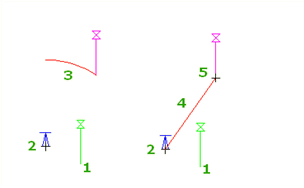You can specify a point location using a deflection angle and a distance from a reference line.
The deflection angle is measured from the reference line’s extension beyond the endpoint, and the distance is measured from the line’s endpoint
The extension of the last two entered points defines the reference line, or you must define a line. From the reference line (1-2) and start point (2), specify a deflection angle (3), and distance (4) to specify a point (5).

The reference line is updated each time you enter a point.
- When you are prompted to enter a point within a command, do one of the following:
- Click Transparent tab
 Plan panel
Plan panel  Deflection Distance
Find.
Deflection Distance
Find.
- Right-click to display the Transparent Commands context menu
 Deflection Distance.
Deflection Distance.
- Activate the Transparent Commands toolbar and select Deflection Distance
 .
.
- Enter 'dd.
- Click Transparent tab
- If you have not yet entered any points in the main command, you must specify a temporary reference line by doing one of the following:
- Select a line.
- Enter p, then specify a start point and endpoint for the line.
- If you have entered one point in the main command, that point is used as the starting point for the temporary reference line. Specify the ending point for the temporary reference line.
- Specify the angle by doing one of the following:
- Click in the drawing.
- Enter a positive or negative numeric value for the angle.
- Enter c to switch the angle between counterclockwise and clockwise, and then specify the angle.
- Specify the distance by either clicking in the drawing or entering a distance.
- If you are prompted, enter a level. For more information, see To Enter a Level for a Transparent Command.
Note: Level prompting for transparent commands is controlled by the Transparent Command setting Prompt For 3D Points. For more information, see About Transparent Command Settings.